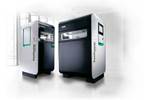Fraunhofer IPA and Arburg Develop 3D-Printed Sensors for Electronic Components
The experts opted for semi-crystalline polybutylene terephthalate (PBT), which is used as standard injection molding material for the production of electronic casing.
While 3D printing opens up many new opportunities, there are still some limitations to overcome. According to the German research group Fraunhofer IPA, the integration of electronic components and the production of customized sensors presented a challenge. However, Fraunhofer IPA,, together with the Baden-Württemberg-based companies Arburg and Balluff, were able to solve this dilemma.
Inductive proximity sensors are available in cylindrical metal casings in which a coil, a circuit board and a plug are installed in a fixed configuration – a standard component with a fixed geometry. In automation technology, inductive proximity sensors are oftentimes used for non-contact detection of metal objects. In industrial applications, they can register the proximity of a component, and also at what distance it is located. However, due to the shape of the casings, inductive proximity sensors for integration in specific environments – robotic arm gripper fingers, for example – had not yet been developed until now.
The research team from the Centre for Additive Production at the Fraunhofer Institute for Manufacturing Engineering and Automation IPA looked into printing the sensor casing in plastic. The team was supported by colleagues from Arburg and the sensor and automation specialist Balluff GmbH. A plastic with high dielectric strength and flame-retardant properties was required for the sensor casing. The experts opted for semi-crystalline polybutylene terephthalate (PBT), which is used as standard injection molding material for the production of electronic casings. However, this type of material had not yet been used for 3D printing.
The plastic was fed in granulate form into Arburg’s freeformer industrial additive manufacturing system, which uses a material preparation unit with a special plasticizing screw. The freeforming process uses a high frequency nozzle to discharge tiny plastic droplets that are positioned with the aid of a movable part carrier.
In this way, the freeformer created three-dimensional components with cavities layer by layer, into which components could be inserted during the printing process. To make this possible, the freeformer automatically interrupted the process at each respective layer, so that the coil, circuit board and plug could be integrated very precisely. In a separate process, a dispenser was then used to produce the silver conductor tracks inside the casing. To complete the process, all that was needed was to overprint the cavities and then pot them in polyurethane.
The team produced more than 30 demonstration models of customized sensors in this way and then put them through the following: the components had to be able to withstand temperature changes and vibrations, they had to be waterproof and pass an electrical insulation test. By optimizing the design and manufacturing process, the tests were completed successfully.
The research project ran for 18 months. Stefan Pfeffer, who led the project at Fraunhofer IPA, is currently working with Arburg on research into how conductive plastics can also be used in the future to tap into additional application areas.

Demonstration model of customized sensor at different production stages: CAD concept (top left), after integration of the electronic components (top right) and as a finished demonstration model (bottom).
Related Content
-
Production Tool, Prototype Time
Mantle's metal 3D printing technology targeted toolmaking and injection molders and moldmakers are taking notice.
-
Freeform Injection Molding Eases the Path to Medical Device Product Testing
A development and manufacturing service provider is using dissolvable molds to build injection molded silicone prototypes.
-
3D Printing of Injection Molds Flows in a New Direction
Hybrids of additive manufacturing and CNC machining can shorten tooling turnaround times.
















